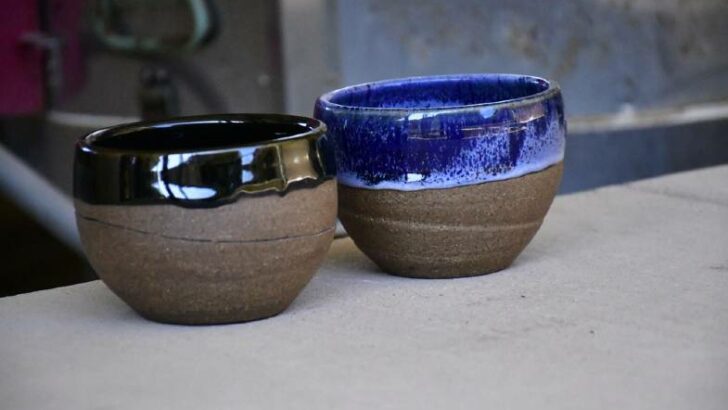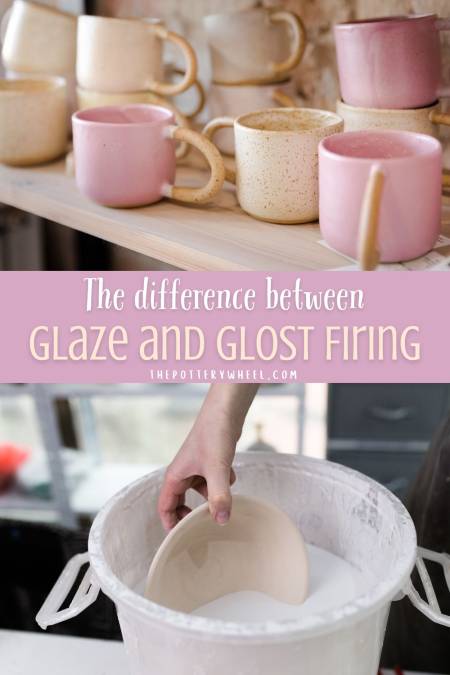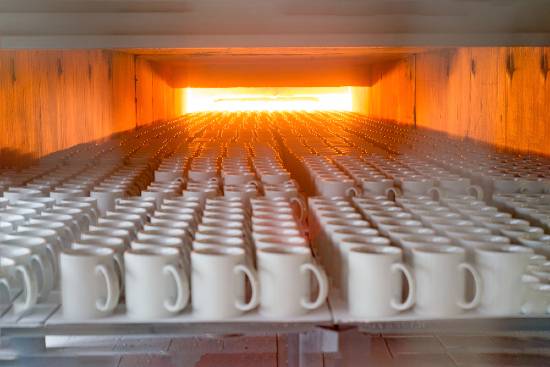Your cart is currently empty!
What is the Second Firing of Clay Called? – Glaze or Glost?
Published:
Last Updated:

Affiliate Disclaimer
As an affiliate, we may earn a commission from qualifying purchases. We get commissions for purchases made through links on this website from Amazon and other third parties.
The most common practice when making ceramics is to fire pottery twice. The first fire is the bisque or biscuit fire. But what is the second firing of clay called?
The second firing of clay is called the glaze fire. After the first fire, liquid glaze is applied to the bisque fired pottery. This is then fired a second time and the glaze melts to form a glassy layer on the pottery. This is glaze firing. It is sometimes called glost firing.
Let’s take a closer look at what glaze firing ceramics consists of and what some of these different terms mean.

An Overview of Glaze Firing
Pottery glaze contains a number of ingredients, but most glazes have three basic ingredients to which others are added.
Think of it like a cake mix. You need flour, sugar, eggs, and butter. Anything else that you add will give the cake a particular look and flavor. But the basic ingredients are what makes it act like a cake in the oven.
Similarly, with pottery glaze, you need the basic ingredients so that the glaze behaves like a glaze in the kiln. These 3 basic ingredients are silica, flux, and alumina.
Silica is a mineral, that when heated to high temperatures melts and forms glass. In a ceramic glaze, the silica melts to form a liquid glass that coats the pottery. When the glaze cools the glass hardens to form a glossy hard coat on the pottery.
However, the silica melts at 3110F (1710C) which is a much higher temperature than ceramic kilns reach. So, the other key ingredient in ceramic glaze is flux. A flux is an oxide that lowers the temperature at which silica melts.
The last key ingredient is alumina, which acts as a stiffening and stabilizing agent in the glaze. It helps the glaze adhere to the ceramic surface.
Also, alumina is added to glaze in the form of a powdered clay like ball clay. When clay is fired, it shrinks. By adding alumina in clay to the glaze, the glaze will also shrink a bit too. This helps the glaze shrink at the same rate as the clay. As a result, the glaze will fit the clay better.
What is the Second Firing of Clay Called?
The last section was an overview of what happens to glaze when it is fired. However, there are many different approaches to glaze firing clay. One of the main differences is the temperature at which glaze is fired.
Glaze manufacturers will specify what temperature a glaze is designed to be fired at. Most commercially available glazes are either low fire earthenware glaze or mid-fire stoneware glazes.
You can also buy glazes that are designed for very high temperatures but these are less readily available.
Low fire glazes would normally be fired at temperatures between 1823-1940F (995-1060C). This is often written as cone 06 – 04. Whereas mid-fire glazes would often be fired at temperatures between 2163-2228F (1184-1220C). Written as cone 5-6.
Most potters will bisque fire their pottery at the same temperature, regardless of what type of clay it is. And regardless of what kind of glaze they are going to apply. Usually, the bisque firing temperature range is somewhere between 1823-1940F (995-1060C). As stated above, this is cone 06 to 04 on the Orton Cone Chart.
However, sometimes pottery is bisque fired at higher temperatures than this. This is a common practice in an industrial setting, where there are advantages to producing very hard bisque ware.
What is the Difference Between Glaze Firing and Glost Firing?
Normally potters will refer to glazing pottery as a glaze fire, regardless of what temperature they are glazing at. This is the most common usage of the term glaze fire.
However, technically ‘glaze firing’ refers to when the temperature in the glaze fire is higher than the bisque fire. Whereas ‘glost firing’ is when the glaze fire is at a lower temperature than was reached in the bisque fire. (The Potter’s Dictionary, F & J Hamer, 2016)
Glost Definition
The term glost fire is one that is inherited from industrial ceramic production. In industry, it’s common practice for pottery to be bisque fired at high temperatures such as 2282F (1250C). Whereas the glaze fire might be around 1976F (1080C).

There are a few reasons for this practice. One is that the bisque pottery is harder and less likely to break in production.
But also, the bisque pottery will be mature and will have undergone any changes that it needs to undergo. So, you are less likely to encounter problems during glazing as the clay matures further.
But actually, glaze firing at lower temperatures is also a practice done by individual potters. For example, earthenware clay is often bisque fired to a temperature a little above the glaze firing temperature.
Other low fire methods of glazing like raku involve glazing at lower temperatures too. So, technically speaking this is a glost glaze, rather than glaze firing.
What Happens in a Glaze Fire?
Unlike a glost fire, during a glaze fire, the clay and the glaze both go through changes. Because the clay is being heated beyond bisque temperatures, it also goes through physical and chemical changes called ‘maturation’. Maturation means that the clay or glaze has become as hard and dense as it can be.
When clay and glaze are fired at a higher temperature than the bisque fire, both ‘mature’ during the glaze fire. When clay and glaze mature, they go through a process called vitrification.
Vitrification means that the glass-forming silicate in the clay and glaze melt. Because both the clay and the glaze are in a molten state, they intermingle and form an intermediate layer. This is the ‘body-glaze’ layer or buffer layer.
There are benefits to glazing at higher temperatures where the clay and glaze intermingle. One of the benefits is that the layer of mixed clay and glaze makes the pottery stronger.
It also makes the glaze less prone to flaking off. By contrast, if the glaze is just sitting on top of the ceramic body, it’s vulnerable to chipping and flaking.
Final Thoughts on the Second Firing of Clay
If you’re wondering what is the second firing of glaze called, it is that normally it’s called the glaze firing. This is fairly standard language used by potters when talking about glazing. However, technically, the terms glaze and glost firing have specific meanings. These meanings are connected to how ceramics are glaze in an industrial setting. And this distinction is often not made in conversation between potters. Nevertheless, it’s helpful to have an understanding of the differences between the two.



